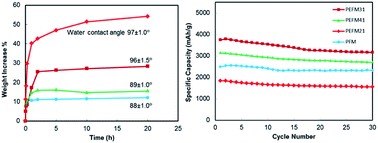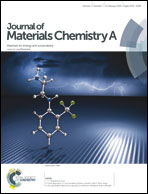Manipulating the polarity of conductive polymer binders for Si-based anodes in lithium-ion batteries
Abstract
Si-based anodes continue to draw tremendous interest for lithium-ion batteries due to their large specific capacity for lithium. However, maintaining the stability while extracting high capacity from Si anodes remains a challenge because of significant volume changes during their electrochemical alloying and de-alloying with lithium. Polymer binder selection and optimization may allow dramatic improvements in the performance of Si-based anodes. Most studies of polymer binders of Si anodes have involved the use of insulating poly(vinylidene fluoride) (PVDF) and carboxyl group containing carboxymethylcellulose (CMC) or poly(acrylic acid) (PAA). Herein, we report for the first time the systematic studies on manipulating the polarity by adjusting the molar ratio of polar triethyleneoxide side chains, therefore the electrolyte up-taking properties change systematically for conductive polyfluorene-based polymer binders. The results show that through optimizing the polarity of polymer binders, superior performance as a binder for Si anodes may be obtained. This study could be used as a model system and may open new avenues to explore a novel series of binders for both insulating and conductive polymer binder families.


 Please wait while we load your content...
Please wait while we load your content...